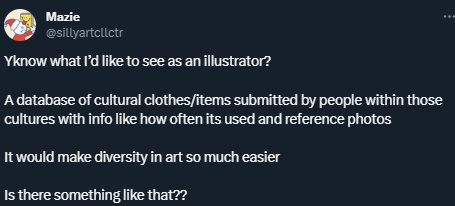Thejunkdrawers - I Might Need It Later...

More Posts from Thejunkdrawers and Others
But now I’m wondering how all these facial recognition algorithms we’re coming up with now are going to take to the Bright New Transhumanist Future
Like, okay, we know Google can recognise dogs. But what about stranger things? Is anyone training these things on lizards?
Imagine basilisks specifically designed to crash these algorithms: abstract-blocks-of-black-and-white-for-heads that, like the QR codes of old, carry a hidden message in their patterning, only it’s a payload, a virus that shreds the system of anyone who tries to capture it on camera, the natural evolution of anti-face-detection camouflage. Imagine things that don’t even have faces, that don’t have an equivalent and easily-cataloguable part; people who deliberately wear mass-produced, identical android bodies, the Guy Fawkes masks of the future.

tweet
Something like this would be so colossally helpful. I'm sick and tired of trying to research specific clothing from any given culture and being met with either racist stereotypical costumes worn by yt people or ai generated garbage nonsense, and trying to be hyper specific with searches yields fuck all. Like I generally just cannot trust the legitimacy of most search results at this point. It's extremely frustrating. If there are good resources for this then they're buried deep under all the other bullshit, and idk where to start looking.
Things that will make your computer meaningfully faster:
Replacing a HDD with an SSD
Adding RAM
Graphics cards if you're nasty
Uninstalling resource hogs like Norton or McAfee (if you're using Windows then the built-in Windows Security is perfectly fine; if you're using a mac consider bitdefender as a free antivirus or eset as a less resource intensive paid option)
Customizing what runs on startup for your computer
Things that are likely to make internet browsing specifically meaningfully faster:
Installing firefox and setting it up with ublock origin
adding the Auto Tab Discard extension to firefox to sleep unused tabs so that they aren't constantly reloading
Closing some fucking tabs bud I'm sorry I know it hurts I'm guilty of this too
Things that will make your computer faster if you are actually having a problem:
Running malwarebytes and shutting down any malicious programs it finds.
Correcting disk utilization errors
Things that will make your computer superficially faster and may slightly improve your user experience temporarily:
Clearing cache and cookies on your browser
Restarting the computer
Changing your screen resolution
Uninstalling unused browser extensions
Things that do not actually make your computer faster:
Deleting files
Registry cleaners
Defragging your drive
Passively wishing that your computer was faster instead of actually just adding more fucking RAM.
This post is brought to you by the lady with the 7-year-old laptop that she refuses to leave overnight for us to run scans on or take apart so that we can put RAM in it and who insists on coming by for 30-minute visits hoping we can make her computer faster.
I can feel…the serotonin and dopamine dropping…i need to make…Crafts
i must make…
b e a d l i z a r d

Social Insects in Science Fiction
Hello, my name is Poetry, and I love social insects. Whether they’re ants, bees, termites, wasps, aphids, thrips, or ambrosia beetles, I find them fascinating to learn about. But if the sci-fi books I read as a kid had had their way, I should have run screaming from every ant colony I saw.
From the buggers in Ender’s Game to the Borg in Star Trek to the Vord in Codex Alera to ants and termites themselves from a morph’s-eye view in Animorphs, social insects, and the aliens or artificial intelligences that closely resemble them, are portrayed as “hive minds” with an emotional tone of existential terror. And I’m here to tell you that these portrayals are totally unfair.
What they get right
Here are some features that most portrayals of social insects and their analogues in sci-fi get right. Yes, social insect colonies have queens that are primarily responsible for reproduction. Yes, social insects have very different sensory modalities from ours. We primarily use sight and sound to communicate and navigate the world, while social insects use taste and smell and vibration. Yes, social insects have specialized division of labor to particular tasks, and yes, they are willing to sacrifice themselves in droves to protect the colony. And sometimes, they will enslave social insects from other colonies or even species to serve their own ends (x).
Thus ends what sci-fi portrayals get right.
What they get wrong: Queens
Almost universally in sci-fi, when you kill the queen, the hive disintegrates into chaos. You’ve cut off the head! The central intelligence of the hive is gone! They’re just mindless borg-units with no idea what to do!
Indeed, in some social insects, such as leafcutter ants, if you kill the queen, the whole colony will die – but probably not for the reasons you think. However, it’s more common for social insects to be able to carry on just fine regardless. In most ants and bees, there are “backup” queens that are reared up by the workers in case the current queen should die. And in many social insects, a worker can step up and become a queen in her place. (Hilariously, a worker ant that steps up to reproduce in place of a queen ant is called a gamergate.)
But here is the most important problem with the sci-fi trope of killing the queen to kill the hive. The queen is not the brain of the hive. She is the ovary.
If you think of a social insect colony as a superorganism, which it’s useful to do in many cases, different groups of insects within the colony act like organs. One caste protects the colony from invaders, which is like an immune system. One caste scouts for new places to forage, which is like a sensory system. Generally, science fiction has a good grip on this idea. Where sci-fi authors fail is that they think the queen is the brain of this superorganism. She is not. She is the reproductive system. The queen does not control what happens in the hive any more than your reproductive system controls what happens in your body. (Which is to say, she has some influence, but she is not the brains of the operation.)
The reason why leafcutter ant colonies die when the queen dies is because the colony has been castrated, not beheaded. Most animals die when they are no longer able to reproduce, even if their brains are still perfectly functional. For castrated colonies with no backup queen or gamergate and no hope of getting one, there is no point in carrying on. Their evolutionary line has ended.
What they get wrong: Swarm intelligence
Here is how social insect hive minds work in science fiction: the queen does the thinking, and the rest of the hive goes along with whatever she thinks.
Now, I’ve already told you that the queen is not the brain of the hive. So where is the brain? Well, that is exactly the point of swarm intelligence. The brain does not reside in one particular animal. It’s an emergent property of many animals working together. A colony is not like your body, where your brain sends an impulse to your mouth telling it to move, and it moves. It’s more like when two big groups of people are walking toward each other, and they spontaneously organize themselves into lanes so no one has a collision (x). There’s no leader telling them to do that, but they do it anyway.
Much of the efficiency of social insect colonies comes from very simple behavioral rules (x). Hymenopterans, the group of insects that includes ants, bees, and wasps, have a behavioral rule: work on a task until it is completed, and when it is done, switch to a different task. If you force solitary bees (yes, most bee species are solitary) to live together, they will automatically arrange themselves into castes, because when one bee sees another bee doing a task like building the nest, its behavioral rule tells it that the task is completed and it needs to switch to a different task, like looking for food.
Individually, a social insect isn’t all that smart, whether it’s a queen, worker, soldier, or drone. But collectively, social insects can do incredibly smart things, like find the most efficient route from the colony to some food (x), or choose the perfect spot to build their hive (x).
What they get wrong: Individuality
The existential terror of the hive mind in science fiction comes from the loss of the self. The idea is that in a social insect colony, there is no individual, but one whole, united to one purpose. No dissent, disagreement, or conflicting interests occur, just total lockstep. I totally get why that’s scary.
The thing is, it’s just not true of real social insects. There is conflict within colonies all the time, up to and including civil war.
A common source of conflict within colonies is worker reproduction. Yes, in most social insects, workers can in fact reproduce, though usually they can only produce males. So why don’t they? Because it’s not in the interest of their fellow workers. Workers are more closely related to their siblings and half-siblings produced by the queen than they are to their nephews, so they pass on more of their genes if they spend resources on raising the queen’s eggs. So, if a worker catches its fellow laying an egg, it will eat the egg. Not exactly “all for one and one for all,” is it?
Worker insects may also fight in wars of succession. If there is more than one queen in a species where queens do not tolerate each other (yes, there are species where multiple queens get along together just fine), such as monogynous fire ants, the workers will ally themselves with one queen or another and engage in very deadly civil war.
Finally, in some species, the queen needs to bully the workers into doing their jobs, and the dominant workers need to bully subordinate workers into doing their jobs (x). Yes, sometimes workers try to laze around and mooch.
Surprisingly human
Here’s what I find weird about depictions of social insects in science fiction. They are portrayed as utterly alien, Other, and horrifying. Yet humans and social insects are very, very similar. The famous sociobiologists E.O. Wilson and Bernard Crespi have both described humans as chimpanzees that took on the lifestyle of ants.
I think what fascinates people, including me, about ants, bees, and their ilk is that you watch, say, a hundred ants working together to tear up a leaf into tiny bits and carry it back to their colony, or a hundred bees all appearing out of seemingly nowhere to sacrifice themselves en masse to stop a bear from eating their hive, and it looks like magic. It really does look like some kind of overmind is controlling their collective actions.
But imagine you’re an alien who comes to Earth, and you know nothing about humans or the way we communicate. Wouldn’t we look exactly the same to them as ants and bees look to us? Wouldn’t they look at us sacrificing our lives by the thousands in wars, or working together to build cities from nothing, and think, Wow, how do they coordinate themselves in such huge numbers, why do they give up their lives to defend their borderlines, I guess there must be some kind of mega-brain they all share that tells them what to do, and they just march in lockstep and do it.
If there’s anything I’ve learned from the study of both social insects and humans, it’s that any system that looks monolithic and simple from a distance is in fact fractured, messy, and complicated when you look at it up close.
Social insects aren’t scary mindless robot-aliens. They’re a lot like you and me. As much as I was terrified as a kid by the Animorphs book where an ant morphs into Cassie and screams in pure existential horror at its sudden individuality, I actually think an ant would adjust very easily to being a human, and that a human would adjust very easily to being an ant – much more easily, in fact, than humans adjusted to morphing, say, sharks, in the very same book series.
Did you know that beetle wings used to be sewn onto dresses? Like, hundreds of them on each dress? It's equally creepy and beautiful.
oh my stars, anyone have pictures?
-
 rebecca-lotto reblogged this · 1 week ago
rebecca-lotto reblogged this · 1 week ago -
 rebecca-lotto reblogged this · 1 week ago
rebecca-lotto reblogged this · 1 week ago -
 thecaptainsassistant reblogged this · 1 week ago
thecaptainsassistant reblogged this · 1 week ago -
 thecaptainsassistant liked this · 1 week ago
thecaptainsassistant liked this · 1 week ago -
 rebecca-lotto reblogged this · 1 week ago
rebecca-lotto reblogged this · 1 week ago -
 ollievion liked this · 1 week ago
ollievion liked this · 1 week ago -
 kitawolf12 reblogged this · 2 weeks ago
kitawolf12 reblogged this · 2 weeks ago -
 mothrater liked this · 2 weeks ago
mothrater liked this · 2 weeks ago -
 madicshop reblogged this · 2 weeks ago
madicshop reblogged this · 2 weeks ago -
 cleverhumancostume reblogged this · 2 weeks ago
cleverhumancostume reblogged this · 2 weeks ago -
 cleverhumancostume liked this · 2 weeks ago
cleverhumancostume liked this · 2 weeks ago -
 localmarsian liked this · 2 weeks ago
localmarsian liked this · 2 weeks ago -
 mustanmustarastas reblogged this · 2 weeks ago
mustanmustarastas reblogged this · 2 weeks ago -
 mxlorax reblogged this · 2 weeks ago
mxlorax reblogged this · 2 weeks ago -
 earlyberry liked this · 2 weeks ago
earlyberry liked this · 2 weeks ago -
 pyrrhum reblogged this · 2 weeks ago
pyrrhum reblogged this · 2 weeks ago -
 parsley-the-crow liked this · 2 weeks ago
parsley-the-crow liked this · 2 weeks ago -
 alpakkanation reblogged this · 2 weeks ago
alpakkanation reblogged this · 2 weeks ago -
 heavythingshere reblogged this · 2 weeks ago
heavythingshere reblogged this · 2 weeks ago -
 biofspades liked this · 2 weeks ago
biofspades liked this · 2 weeks ago -
 kindfulkirby reblogged this · 2 weeks ago
kindfulkirby reblogged this · 2 weeks ago -
 schmackie reblogged this · 2 weeks ago
schmackie reblogged this · 2 weeks ago -
 drivingthesehillsaway reblogged this · 2 weeks ago
drivingthesehillsaway reblogged this · 2 weeks ago -
 drivingthesehillsaway liked this · 2 weeks ago
drivingthesehillsaway liked this · 2 weeks ago -
 possumpunky reblogged this · 2 weeks ago
possumpunky reblogged this · 2 weeks ago -
 childofdemon reblogged this · 2 weeks ago
childofdemon reblogged this · 2 weeks ago -
 childofdemon liked this · 2 weeks ago
childofdemon liked this · 2 weeks ago -
 tabbyfeathers reblogged this · 2 weeks ago
tabbyfeathers reblogged this · 2 weeks ago -
 whaddyagonnadoehhh liked this · 2 weeks ago
whaddyagonnadoehhh liked this · 2 weeks ago -
 illyrienne reblogged this · 2 weeks ago
illyrienne reblogged this · 2 weeks ago -
 odiomnibusvobis reblogged this · 2 weeks ago
odiomnibusvobis reblogged this · 2 weeks ago -
 coffeesgrandsarcasm liked this · 2 weeks ago
coffeesgrandsarcasm liked this · 2 weeks ago -
 kittiesarecuter liked this · 2 weeks ago
kittiesarecuter liked this · 2 weeks ago -
 instantmilktee reblogged this · 2 weeks ago
instantmilktee reblogged this · 2 weeks ago -
 instantmilktee liked this · 2 weeks ago
instantmilktee liked this · 2 weeks ago -
 seventhpaw reblogged this · 2 weeks ago
seventhpaw reblogged this · 2 weeks ago -
 seventhpaw liked this · 2 weeks ago
seventhpaw liked this · 2 weeks ago -
 discount-brain-matter reblogged this · 2 weeks ago
discount-brain-matter reblogged this · 2 weeks ago -
 looking-aroundatstuff liked this · 2 weeks ago
looking-aroundatstuff liked this · 2 weeks ago -
 emjoyy reblogged this · 2 weeks ago
emjoyy reblogged this · 2 weeks ago -
 nope-astrology-nope reblogged this · 2 weeks ago
nope-astrology-nope reblogged this · 2 weeks ago -
 chthoniccakewalk reblogged this · 2 weeks ago
chthoniccakewalk reblogged this · 2 weeks ago -
 stitching-in-time reblogged this · 2 weeks ago
stitching-in-time reblogged this · 2 weeks ago -
 revolucionariainapolicebox liked this · 2 weeks ago
revolucionariainapolicebox liked this · 2 weeks ago -
 uncontrollablequeerentity liked this · 2 weeks ago
uncontrollablequeerentity liked this · 2 weeks ago -
 silver9mm reblogged this · 2 weeks ago
silver9mm reblogged this · 2 weeks ago -
 vestal-virgin liked this · 2 weeks ago
vestal-virgin liked this · 2 weeks ago -
 adrianovich97 liked this · 2 weeks ago
adrianovich97 liked this · 2 weeks ago -
 katarzyna-kedzierzawa reblogged this · 2 weeks ago
katarzyna-kedzierzawa reblogged this · 2 weeks ago -
 rejectingboundsandfinity liked this · 2 weeks ago
rejectingboundsandfinity liked this · 2 weeks ago

A side blog where I'll *try* to keep things organised.yeahthatsnotgoingtolastlong
241 posts








